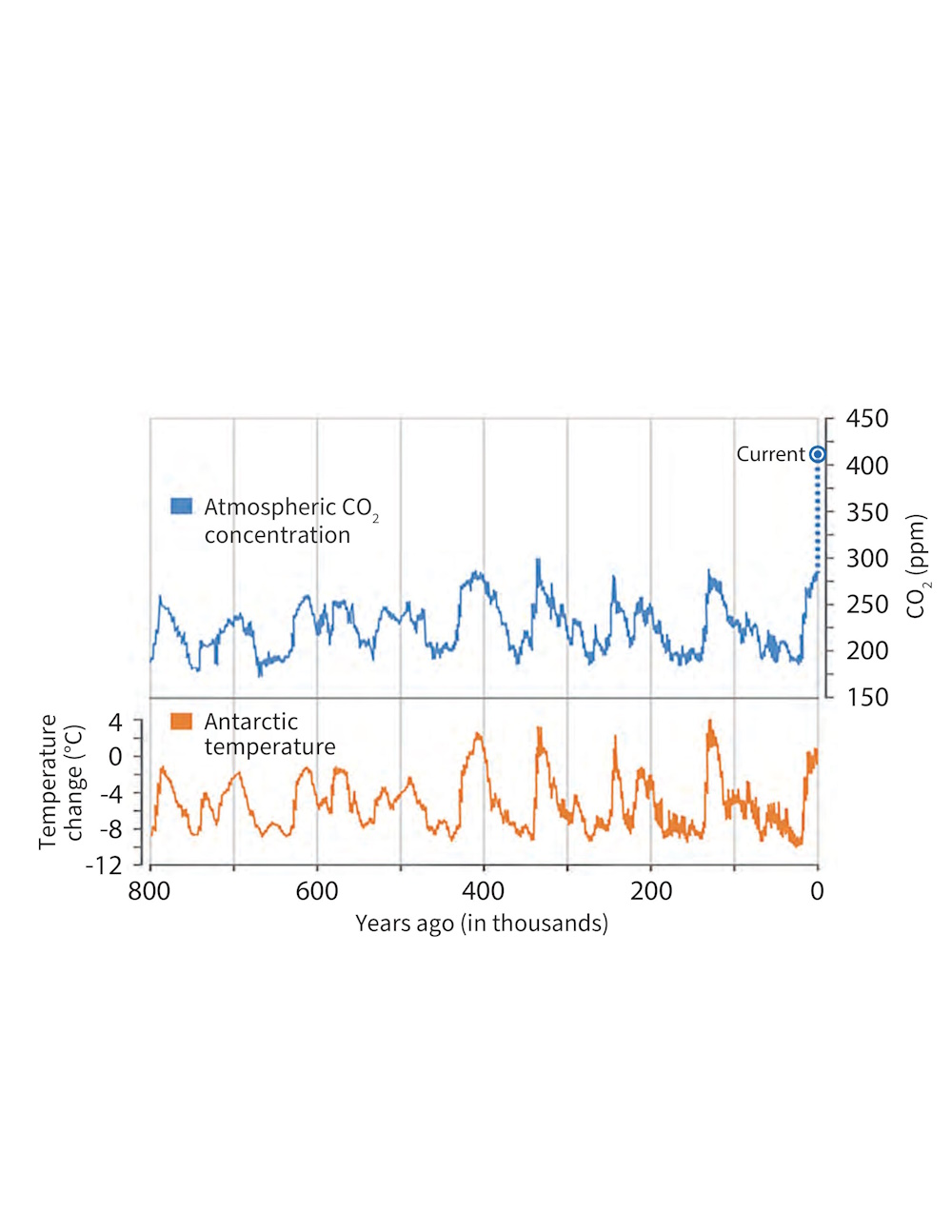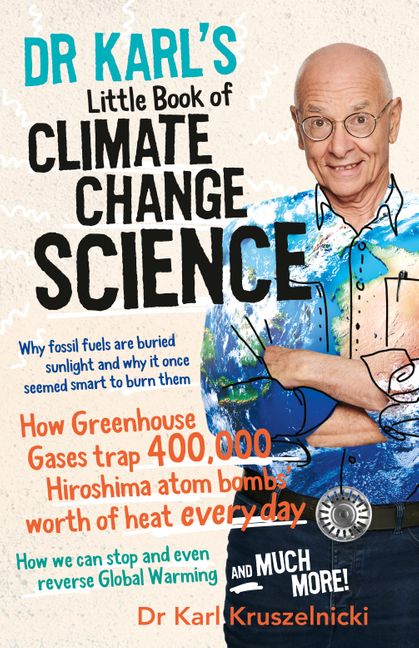
The Unprecedented Level of Atmospheric CO2 Concentration
The present level of atmospheric CO2 concentration is almost certainly unprecedented in the past million years, during which time modern humans evolved and societies developed. The atmospheric CO2 concentration was however higher in Earth’s more distant past (many millions of years ago), at which time palaeoclimatic and geological data indicate that temperatures and sea levels were also higher than they are today.
Measurements of Atmospheric CO2 Concentration
Measurements of air in ice cores show that for the past 800,000 years up until the 20th century, the atmospheric CO2 concentration stayed within the range 170 to 300 parts per million (ppm), making the recent rapid rise to more than 400 ppm over 200 years particularly remarkable [figure 3]. During the glacial cycles of the past 800,000 years both CO2 and methane have acted as important amplifiers of the climate changes triggered by variations in Earth’s orbit around the Sun. As Earth warmed from the last ice age, temperature and CO2 started to rise at approximately the same time and continued to rise in tandem from about 18,000 to 11,000 years ago. Changes in ocean temperature, circulation, chemistry, and biology caused CO2 to be released to the atmosphere, which combined with other feedbacks to push Earth into an even warmer state.
CO2 Concentrations in Geological Times
For earlier geological times, CO2 concentrations and temperatures have been inferred from less direct methods. Those suggest that the concentration of CO2 last approached 400 ppm about 3 to 5 million years ago, a period when global average surface temperature is estimated to have been about 2 to 3.5°C higher than in the pre-industrial period. At 50 million years ago, CO2 may have reached 1000 ppm, and global average temperature was probably about 10°C warmer than today. Under those conditions, Earth had little ice, and sea level was at least 60 metres higher than current levels.
Data from Ice Cores

Figure 3. Data from ice cores have been used to reconstruct Antarctic temperatures and atmospheric CO2 concentrations over the past 800,000 years. Temperature is based on measurements of the isotopic content of water in the Dome C ice core. CO2 is measured in air trapped in ice, and is a composite of the Dome C and Vostok ice core. The current CO2 concentration (blue dot) is from atmospheric measurements. The cyclical pattern of temperature variations constitutes the ice age/ interglacial cycles. During these cycles, changes in CO2 concentrations (in blue) track closely with changes in temperature (in orange). As the record shows, the recent increase in atmospheric CO2 concentration is unprecedented in the past 800,000 years. Atmospheric CO2 concentration surpassed 400 ppm in 2016, and the average concentration in 2019 was more than 411 ppm. Source: Based on figure by Jeremy Shakun, data from Lüthi et al., 2008 and Jouzel et al., 2007.
Conclusion
The unprecedented level of atmospheric CO2 concentration highlights the urgent need to address climate change and work towards achieving the Sustainable Development Goals (SDGs). The SDGs aim to promote sustainable development and combat climate change by addressing various global challenges, including reducing greenhouse gas emissions and promoting renewable energy sources. It is crucial for governments, organizations, and individuals to take action and implement measures that contribute to the achievement of these goals in order to mitigate the impacts of climate change and ensure a sustainable future for generations to come.
Page last updated: March 2020
Learn More
Find out about the Royal Society’s latest work on climate change and biodiversity
SDGs, Targets, and Indicators
-
SDG 13: Climate Action
- Target 13.1: Strengthen resilience and adaptive capacity to climate-related hazards and natural disasters
- Target 13.2: Integrate climate change measures into national policies, strategies, and planning
- Target 13.3: Improve education, awareness-raising, and human and institutional capacity on climate change mitigation, adaptation, impact reduction, and early warning
- Target 13.a: Implement the commitment undertaken by developed-country parties to the United Nations Framework Convention on Climate Change to a goal of mobilizing jointly $100 billion annually by 2020 from all sources to address the needs of developing countries in the context of meaningful mitigation actions and transparency on implementation and fully operationalize the Green Climate Fund through its capitalization as soon as possible
- Target 13.b: Promote mechanisms for raising capacity for effective climate change-related planning and management in least developed countries and small island developing states, including focusing on women, youth, and local and marginalized communities
The article discusses the unprecedented rise in atmospheric CO2 concentration, which is directly related to climate change. The targets under SDG 13 that can be identified based on the article’s content include strengthening resilience to climate-related hazards, integrating climate change measures into policies and planning, improving education and awareness on climate change, mobilizing financial resources for developing countries, and promoting capacity building in vulnerable regions.
-
SDG 14: Life Below Water
- Target 14.3: Minimize and address the impacts of ocean acidification, including through enhanced scientific cooperation at all levels
- Target 14.5: By 2020, conserve at least 10 percent of coastal and marine areas, consistent with national and international law and based on the best available scientific information
- Target 14.a: Increase scientific knowledge, develop research capacity, and transfer marine technology, taking into account the Intergovernmental Oceanographic Commission Criteria and Guidelines on the Transfer of Marine Technology, in order to improve ocean health and to enhance the contribution of marine biodiversity to the development of developing countries, in particular small island developing states and least developed countries
The article mentions the impact of CO2 on ocean temperature, circulation, chemistry, and biology. This connects to SDG 14, which focuses on life below water. The targets under SDG 14 that can be identified based on the article’s content include addressing ocean acidification, conserving coastal and marine areas, and enhancing scientific knowledge and research capacity for improving ocean health.
| SDGs | Targets | Indicators |
|---|---|---|
| SDG 13: Climate Action |
|
No specific indicators mentioned in the article. |
| SDG 14: Life Below Water |
|
No specific indicators mentioned in the article. |
Behold! This splendid article springs forth from the wellspring of knowledge, shaped by a wondrous proprietary AI technology that delved into a vast ocean of data, illuminating the path towards the Sustainable Development Goals. Remember that all rights are reserved by SDG Investors LLC, empowering us to champion progress together.
Source: royalsociety.org

Join us, as fellow seekers of change, on a transformative journey at https://sdgtalks.ai/welcome, where you can become a member and actively contribute to shaping a brighter future.





